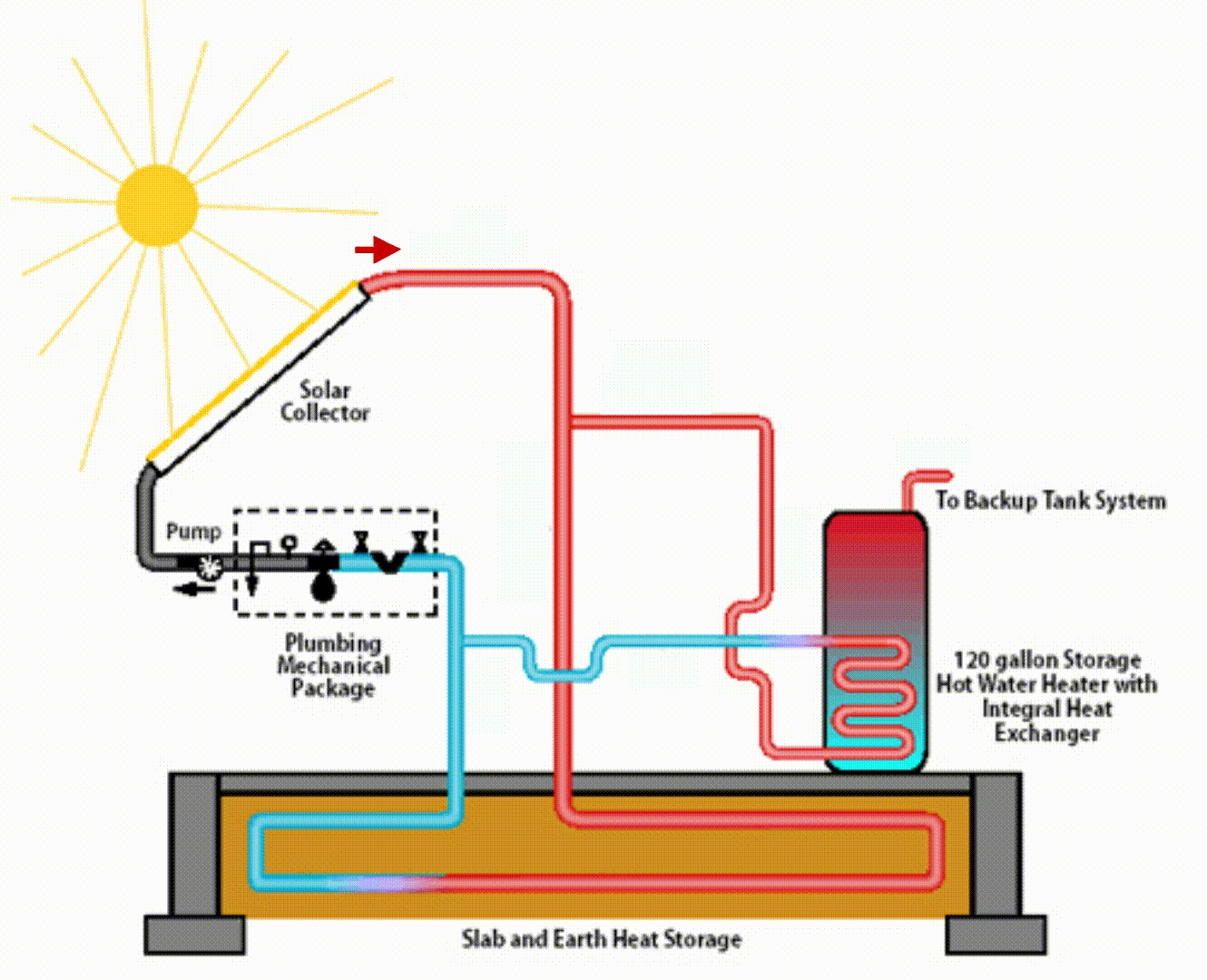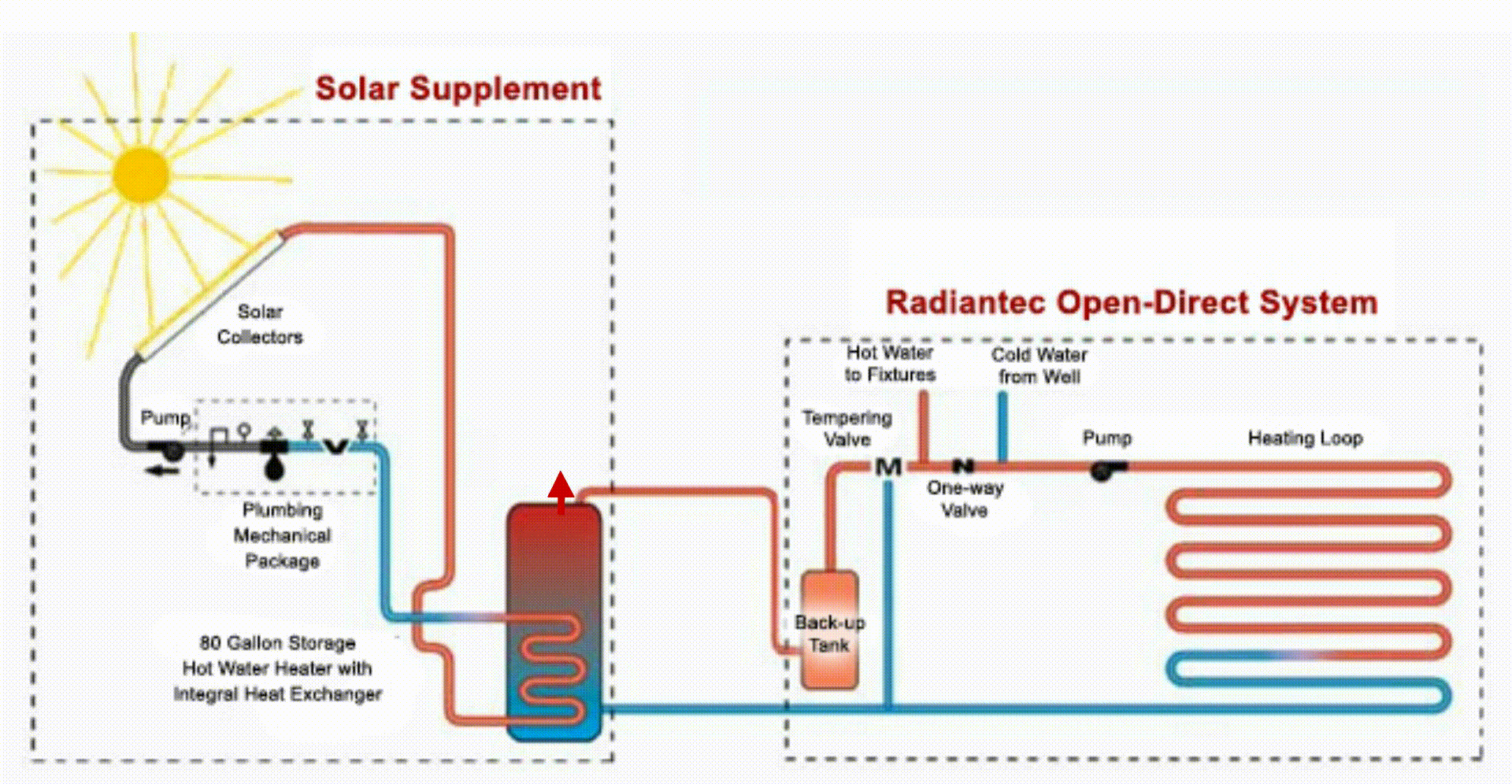Solar Heating Options
Here are some of the things that a solar heating system can do for you:
RADIANT HEATING
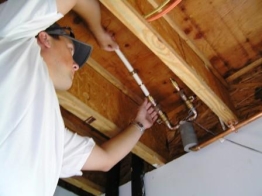 Underfloor radiant heating in general is enjoying
resurgence in popularity because of the benefits of comfort and energy
efficiency.
Underfloor radiant heating in general is enjoying
resurgence in popularity because of the benefits of comfort and energy
efficiency.
Now, for alternative energy, radiant heating is becoming the method of choice for space heating because it enables low temperature operation which is important for solar energy collection and also because the solar energy can be stored efficiently within a radiant system.
This link can be followed for a more comprehensive study of the many advantages of radiant heating. http://www.radiantec.com/why
The sun is the mother of all radiant heating systems and its partnership with mechanical, earthly underfloor radiant systems is a good thing. There are many benefits to the combination, and this appreciation has taken the practice of solar heating design to an entirely new level.
It is most efficient to use solar energy directly to make underfloor radiant heat. Earlier solar heating systems would first heat a storage tank and then distribute the stored heat with radiant heating tubes. When solar energy is used directly to provide radiant heat, the radiant floor system cannot be used by the backup heating system as this use would compromise the solar storage. This method can be used but it is much less efficient than a direct application.
Here are several specific uses whereby you can combine solar energy with radiant heating directly.
- Massive Storage A large thermal storage place is developed by slab on grade construction and strategic placement of the insulation. This award winning design is called the Solar Option I and is perhaps the most powerful and useful solar heating design that is available. (below)
- Installation within joisted floors
- Domestic Hot Water Plus Radiant Heat
- Property protection
- Radiant comfort
- Supplemental Uses
- Snow melting
- Gardening
- Hot tubs and pools
The Solar Option I Heating System

Domestic Hot Water and Space Heating With Long Term Passive Heat Storage
This is the most powerful of the Radiantec heating systems. It is a "hybrid" system that combines the best features of "active" and "passive" technologies while leaving behind their respective disadvantages.
ADVANTAGES AND BENEFITS
A significant advantage of the Solar Option I system is that it is capable of meeting nearly all of a residential type building's heating needs, even in quite challenging climates. Another advantage is exceptionally high efficiency that very low operating temperatures entail. "Substantial improvements were noted in system efficiency, overall performance, initial cost and architectural flexibility. An increase in collector efficiency translates into fewer solar panels, lowered costs,and easier design integration into accepted building styles. A large thermal mass, integrated within the building's structure provides prolonged solar storage, radiant comfort and further lowered costs."
-Report to US Department of Energy
1983 (DOE/CE15140-T)
The Solar Option I is applicable to new slab on grade buildings. It uses the structure's inherent ability to store heat energy and that must be designed in from the beginning.
The sun will shine upon 7 or more solar collectors. Solar energy will be stored within an 120 gallon solar storage tank for domestic hot water and within a 2' thick slab and compacted earth bed for long-term space heating storage.
|
Massive Storage A very large thermal storage area is created with slab on grade construction. The storage area consists of the slab itself and up to two feet of compacted sand or gravel. The storage detail can have very little or no additional cost depending upon insulation. Despite reports to the contrary, there are no annualizing benefits, or storage that carries over from season to season. |
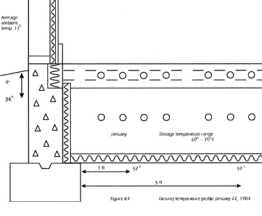
|
| The very large thermal storage area, when coupled to solar collectors produces high solar collector efficiency, a potential for high solar heating fractions, reasonable first cost and very good cost benefits, all within a startling simple design. |
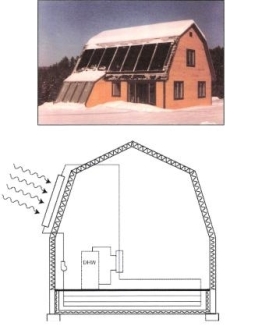
|
|
Installation within joisted floors Installation in a joisted floor is a snap in new construction and is also an easy retrofit in an existing home if you have access to your floor joists from below. The wooden floor system won't store as much energy as a slab system, but it can still store significant heat and will result in a very comfortable and warm floor. |
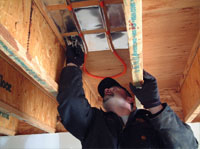
|
|
Domestic hot water plus radiant heat The solar domestic water heater is itself an attractive option. It is not always convenient to provide the very large heat storage mass that is used with the Solar Option One. Also, it is not always possible to install a large number of solar panels. In such cases, a domestic hot water heater with a supplemental heating potential can have value. When a less aggressive storage mass is used, such as a topping slab over plywood, or ceramic floor tiles or even a regular wood floor system, the floor system can still provide appreciable benefit. |
|
|
Property protection of seasonal homes There is abundant domestic hot water when the building is occupied, and when unoccupied, the solar keeps the building at a minimal temperature with minimal cost. The floor and building itself can function as solar storage because a wide range of temperatures is acceptable (i.e. 45-85 degrees F). |
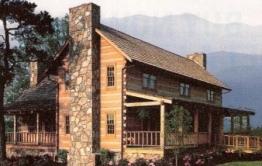
|
|
Supplemental Radiant Comfort The floor can be quite cold when the building is under heavy heating load. When the floor is brought up to warm temperatures, comfort is greatly increased and load is taken off the heating system for lower energy bills. |

|
The Solar Option II Heating System

The Solar Option II is the most popular heating system because it is so versatile; a single heating system that can do many things. Solar Option II uses the sun's energy to make space heat, domestic hot water, and even heat for swimming pools and snow melting.
It even provides a limited amount of free cooling in the summer.
Solar Option II can be used with both new and retrofit applications.
Solar collectors can be placed on the home itself, or they can also be located on the garage or outside storage building. Solar collectors can be ground mounted and landscaped so that they provide privacy and shelter from the wind.
Solar Option II: Low cost, efficient, easy to install, and flexible.
Solar Option II will lower your fossil fuel use to a fraction of what it would have been. You will often have luxurious amounts of heat and hot water for free. A high efficiency backup heater makes sure you never run out. You can use solar energy for snow melting, & and even extend the season in your pool or garden.
Operation
The sun will shine upon 5-6 liquid type solar collectors (4' x 8' typical). The solar energy will be stored in one or more 80-gallon solar storage tanks.
Heat for the building is provided by underfloor radiant heat, the most comfortable and efficient heat that there is.
In the summer, cold water passes through the floors before it goes to the fixtures. Heat is taken out of the house for FREE!
Performance Expected
Solar Option II will provide most of the domestic hot water and 30-90% of the space heating needs. Higher solar percentages are possible with additional storage tanks, but cost performance will decrease.
Supplementary Solar Applications
|
Snow melting Snow melting is a task that can be accomplished with quite low temperature solar fluid. Often this application can be carried out with low grade solar availability that is not useful for anything else. Mechanically, it is just another radiant heating zone that is controlled manually with a simple ball valve. It is a good example of an application that is quite reasonable to accomplish with solar energy that would be somewhat wasteful to accomplish with fossil fuels. |
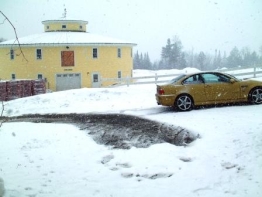
|
|
Gardening The gardening application is mechanically similar to snow melting. Radiant heating tubes are placed in ditches about 1½ ft below the surface. Root zone heating is known to benefit plant growth and extend the growing season. It is another very low temperature application that can be conducted without sacrificing the primary use for the solar energy. |
|
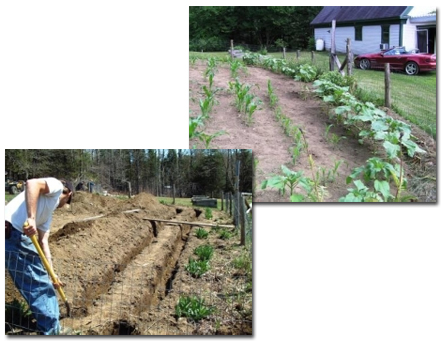
|

|
Our solar technicians are always ready to answer questions.
Call 1-800-451-7593



